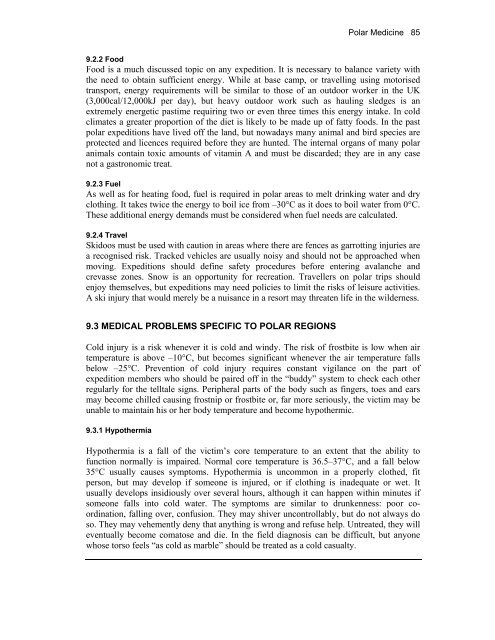Edited by Rachel Duncan 4th Edition ISBN 0-907649-91-2 London ...
Edited by Rachel Duncan 4th Edition ISBN 0-907649-91-2 London ...
Edited by Rachel Duncan 4th Edition ISBN 0-907649-91-2 London ...
Create successful ePaper yourself
Turn your PDF publications into a flip-book with our unique Google optimized e-Paper software.
Polar Medicine 85<br />
9.2.2 Food<br />
Food is a much discussed topic on any expedition. It is necessary to balance variety with<br />
the need to obtain sufficient energy. While at base camp, or travelling using motorised<br />
transport, energy requirements will be similar to those of an outdoor worker in the UK<br />
(3,000cal/12,000kJ per day), but heavy outdoor work such as hauling sledges is an<br />
extremely energetic pastime requiring two or even three times this energy intake. In cold<br />
climates a greater proportion of the diet is likely to be made up of fatty foods. In the past<br />
polar expeditions have lived off the land, but nowadays many animal and bird species are<br />
protected and licences required before they are hunted. The internal organs of many polar<br />
animals contain toxic amounts of vitamin A and must be discarded; they are in any case<br />
not a gastronomic treat.<br />
9.2.3 Fuel<br />
As well as for heating food, fuel is required in polar areas to melt drinking water and dry<br />
clothing. It takes twice the energy to boil ice from –30°C as it does to boil water from 0°C.<br />
These additional energy demands must be considered when fuel needs are calculated.<br />
9.2.4 Travel<br />
Skidoos must be used with caution in areas where there are fences as garrotting injuries are<br />
a recognised risk. Tracked vehicles are usually noisy and should not be approached when<br />
moving. Expeditions should define safety procedures before entering avalanche and<br />
crevasse zones. Snow is an opportunity for recreation. Travellers on polar trips should<br />
enjoy themselves, but expeditions may need policies to limit the risks of leisure activities.<br />
A ski injury that would merely be a nuisance in a resort may threaten life in the wilderness.<br />
9.3 MEDICAL PROBLEMS SPECIFIC TO POLAR REGIONS<br />
Cold injury is a risk whenever it is cold and windy. The risk of frostbite is low when air<br />
temperature is above –10°C, but becomes significant whenever the air temperature falls<br />
below –25°C. Prevention of cold injury requires constant vigilance on the part of<br />
expedition members who should be paired off in the “buddy” system to check each other<br />
regularly for the telltale signs. Peripheral parts of the body such as fingers, toes and ears<br />
may become chilled causing frostnip or frostbite or, far more seriously, the victim may be<br />
unable to maintain his or her body temperature and become hypothermic.<br />
9.3.1 Hypothermia<br />
Hypothermia is a fall of the victim’s core temperature to an extent that the ability to<br />
function normally is impaired. Normal core temperature is 36.5–37°C, and a fall below<br />
35°C usually causes symptoms. Hypothermia is uncommon in a properly clothed, fit<br />
person, but may develop if someone is injured, or if clothing is inadequate or wet. It<br />
usually develops insidiously over several hours, although it can happen within minutes if<br />
someone falls into cold water. The symptoms are similar to drunkenness: poor coordination,<br />
falling over, confusion. They may shiver uncontrollably, but do not always do<br />
so. They may vehemently deny that anything is wrong and refuse help. Untreated, they will<br />
eventually become comatose and die. In the field diagnosis can be difficult, but anyone<br />
whose torso feels “as cold as marble” should be treated as a cold casualty.

















